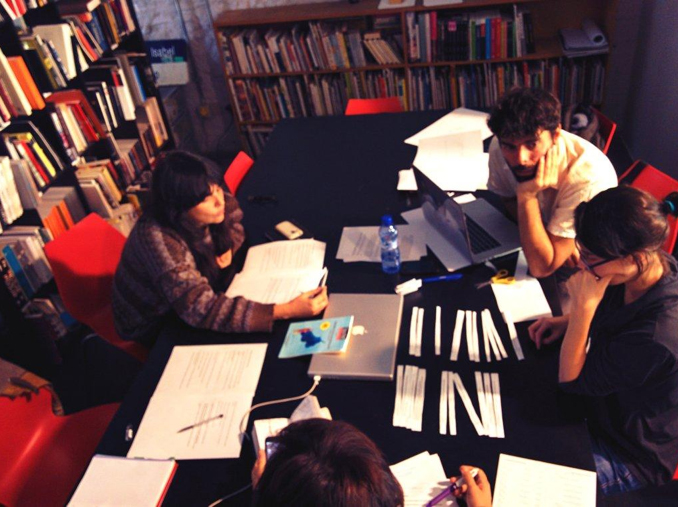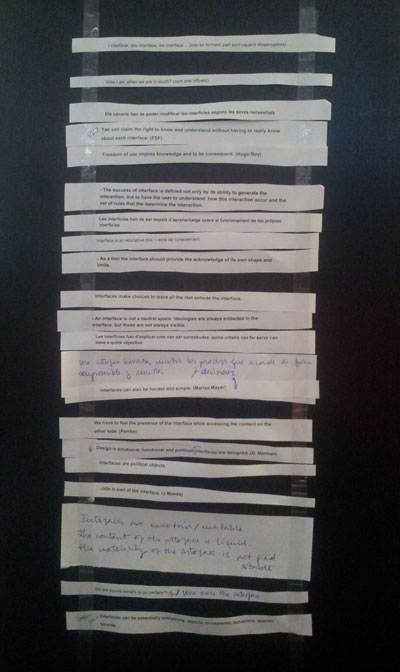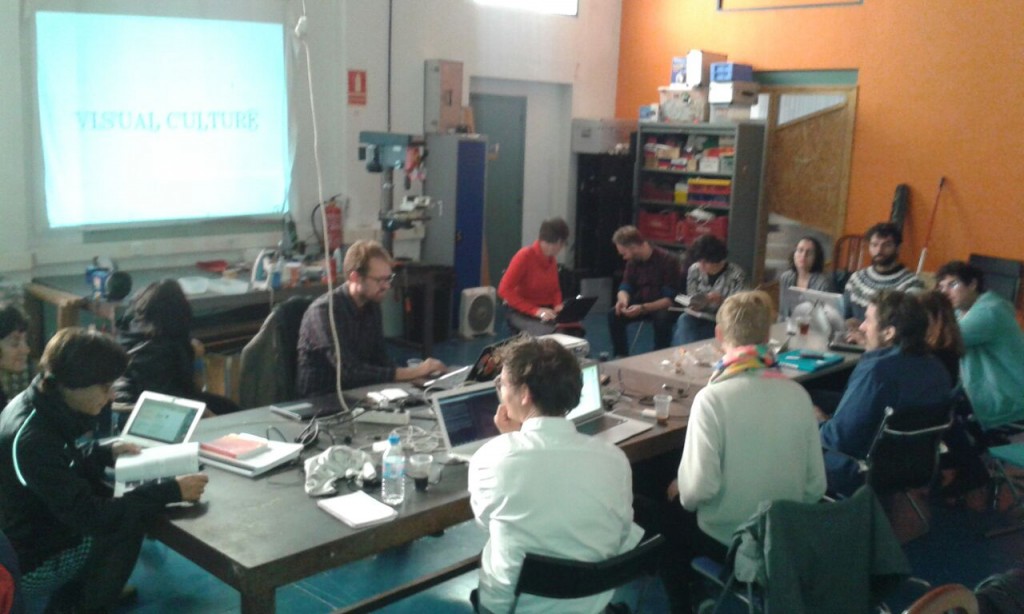In the framework of PIPES BCN research, the 1st of July Hangar hosted an Art Matters Seminar focused on interfaces, the research issue of the project. In this occasion, besides of the usual attendees we had an special guest: Jorge Luís Marzo, exhibition curator, writer and lecturer at the Bau University School.
After the traditional presentation of the seminar and the attendees introduction, Jorge sugested that devices should turn into interfaces: there is a need that machines could socialize with each other and people, and added that now there is an independence of the (TV) screen, because screens are everywhere.
Regarding to this, other of the participants introduced the idea of relational spaces from social scientist and geographer Doreen Massey, to highlight the space where humans and not humans relate. Following this path, seminar leader Pau Alsina added that there is a relation between the material and the symbolic, and explained that the concept of infrastructure from Bruno Latour is very useful to attend this.
In fact, as Pau clarified, one of the seminar aims is to fight the perspective of researching things (as art, etc.) regardless of their ability of agency. Thinking about interface, some authors placed the software in the center of the analysis (Manovich, i.e). In a similar way, the essay Interface Criticism: Aesthetic Beyond Buttons, Christian Ulrik Andersen and Soren Bor Pold (as editors) attempts to enter into the interface, thinking about it not just as a mere surface in which political and social conditioning bounce, but as a society articulator.
Another participant added that there is a need of artistic practices questioning these phenomena. The devices are sociability producers, a trigger for social behaviours, and STS studies can help to understand which are the processes through which this standards crystalize. The interface should not be explained but is the explanation, which conveys.
Some authors sharing this point of view are Mathew Fuller, crossing cultural studies with software studies, or Michel Callon, an engineer and sociologist. The actor-network theory and relational materialism are useful perspectives to understand the interface as a complex phenomena, given that they understand technosciencies as a net that includes both human and non-human entities, heeding to the associations between them.
A good example of the success of certain technologies from this approach is the coding language Processing. It has become so popular and used because it has been developed for artists to artists, and has opened a new field of accessible creativity that can be translated from the art field to the industry, and where creators, technologist, coders or scientists can converge.
Building a Manifesto
One of the goals of PIPES BCN is to write an Interface Manifesto. Talking about that, Jorge Luís Marzo said that images may not represent the reality but hide it (as happens in the film The Matrix). The texts are disappearing and being replaced by icons or images full of meaning (Twitter bird, for example, or F by Facebook).
Nowadays, societies live dazzled by the new gadgets and technological services provided by the industry, there’s a technophilic layer that can bring to technical nihilism. We enjoy the latests technologies, but where is the responsability? There can be pointed just one actor?
In the case of interface, what is important is not just the object, but the function of this object in a certain context. This is the argument that defends the article An Introduction to Interface Phenomenology from Josep M. Català. Interface translates more than mediates (mediate has a friendly connotation), and it only exists when there is a need for dialogue. Interfaces are part of our lives, and despite the wide variety of devices, they tend to the homogenization and standarization. Related to technology, there has always been a search for universal languages and standards. The screws are an example, as well as internet protocols.
In technology there’s no neutrality, although there certainly is an illusion of it. It’s stories are bounded to the idea of progress, and preconceptions of human being or ideas related to power are embodied in those objects and the practices they enable. When talking about interface, it seems to be a request coming from users: give me buttons. The designers or engineers of our washing machines, radios or computers seem to say: just press the button and we do the rest. Here are clearly a number of preconceptions that shows us that the dichotomy between active subject and passive object is completely obsolete.




